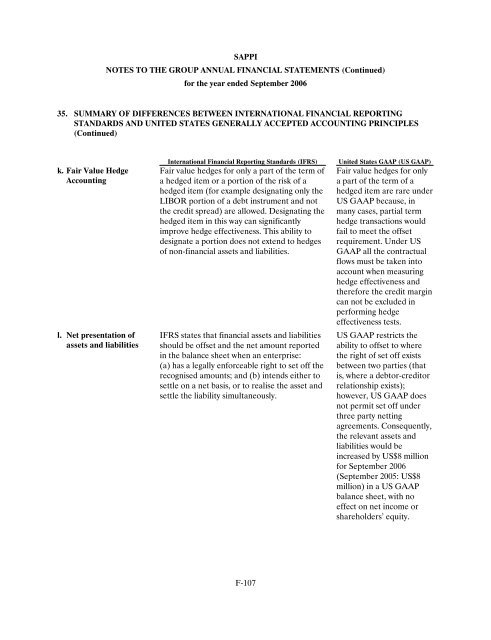Create successful ePaper yourself
Turn your PDF publications into a flip-book with our unique Google optimized e-Paper software.
SAPPI<br />
NOTES TO THE GROUP ANNUAL FINANCIAL STATEMENTS (Continued)<br />
for the year ended September <strong><strong>20</strong>06</strong><br />
35. SUMMARY OF DIFFERENCES BETWEEN INTERNATIONAL FINANCIAL REPORTING<br />
STANDARDS AND UNITED STATES GENERALLY ACCEPTED ACCOUNTING PRINCIPLES<br />
(Continued)<br />
k. Fair Value Hedge<br />
Accounting<br />
l. Net presentation of<br />
assets and liabilities<br />
International Financial Reporting Standards (IFRS) United States GAAP (US GAAP)<br />
Fair value hedges for only a part of the term of<br />
a hedged item or a portion of the risk of a<br />
hedged item (for example designating only the<br />
LIBOR portion of a debt instrument and not<br />
the credit spread) are allowed. Designating the<br />
hedged item in this way can significantly<br />
improve hedge effectiveness. This ability to<br />
designate a portion does not extend to hedges<br />
of non-financial assets and liabilities.<br />
IFRS states that financial assets and liabilities<br />
should be offset and the net amount reported<br />
in the balance sheet when an enterprise:<br />
(a) has a legally enforceable right to set off the<br />
recognised amounts; and (b) intends either to<br />
settle on a net basis, or to realise the asset and<br />
settle the liability simultaneously.<br />
F-107<br />
Fair value hedges for only<br />
a part of the term of a<br />
hedged item are rare under<br />
US GAAP because, in<br />
many cases, partial term<br />
hedge transactions would<br />
fail to meet the offset<br />
requirement. Under US<br />
GAAP all the contractual<br />
flows must be taken into<br />
account when measuring<br />
hedge effectiveness and<br />
therefore the credit margin<br />
can not be excluded in<br />
performing hedge<br />
effectiveness tests.<br />
US GAAP restricts the<br />
ability to offset to where<br />
the right of set off exists<br />
between two parties (that<br />
is, where a debtor-creditor<br />
relationship exists);<br />
however, US GAAP does<br />
not permit set off under<br />
three party netting<br />
agreements. Consequently,<br />
the relevant assets and<br />
liabilities would be<br />
increased by US$8 million<br />
for September <strong><strong>20</strong>06</strong><br />
(September <strong>20</strong>05: US$8<br />
million) in a US GAAP<br />
balance sheet, with no<br />
effect on net income or<br />
shareholders’ equity.
















